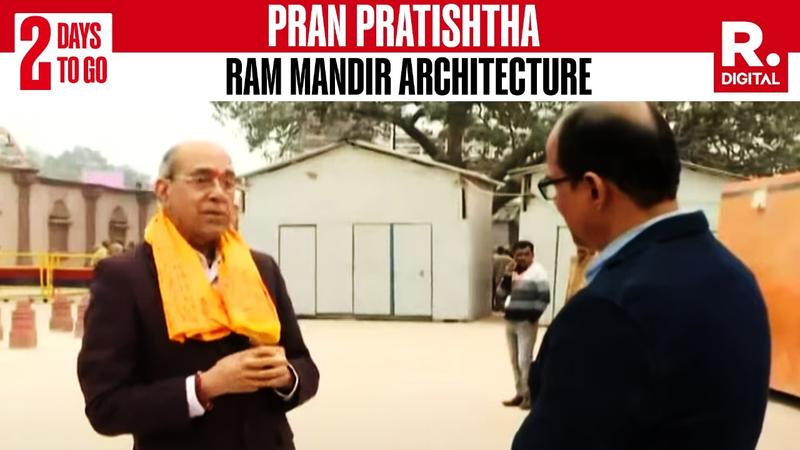Published 20:46 IST, January 20th 2024
Soil To Parkota: Officer-architect-in-chief Nripendra Misra Reveals Details of Making of Ram Mandir
Nripendra Misra delved into various aspects, starting from the challenges posed by the tricky soil in Ayodhya to the intricacies of Mandir engineering.

Ayodhya: In an exclusive interview with Republic TV, Nripendra Misra, Ayodhya's officer-architect-in-chief, shared vital insights into the construction of the magnificent Ram Temple. His journey from being the Principal Secretary to two UP CMs and witnessing the Ram temple movement firsthand to becoming the top bureaucrat in Prime Minister Narendra Modi's first PMO to being positioned at the helm of the temple construction project, the tell-all interview of Ram Mandir Construction Committee chairman is full of unknown details behind the making of the Ram Temple.
Nripendra Misra delved into various aspects, starting from the challenges posed by the tricky soil in Ayodhya to the intricacies of Mandir engineering. Having a ringside view of the entire process, Misra provided detailed information on the hurdles faced during the construction of the historic temple.
Nripendra Misra's wealth of experience and his integral role in overseeing the development of the Ram Temple make him a key figure in the realisation of this significant project. The Republic Super Exclusive segment shed light on the dedication and meticulous planning involved in bringing the vision of the Ram Temple to life in Ayodhya.
"The newly installed idol at the Ram Temple in Ayodhya portrays Lord Ram as a five-year-old boy standing in a divine posture. This 'achal' idol is set to remain immovable, firmly stationed in its designated place within the temple following the Pran Pratishtha ceremony," Nripendra Misra said.
He also informed that in a significant arrangement, the smaller idol, formerly housed in the temporary temple, will now find its place directly in front of the new idol on the same 'singhasan'. Referred to as the Utsav Murti, this smaller idol comes with the flexibility to occasionally leave the temple premises during special festivals, providing devotees with the opportunity to receive Darshan.
In a detailed discussion on the intricate engineering aspects of the Ram Temple's construction, Nripendra Misra provided insights into the architectural features that devotees will encounter on their journey to seek blessings at the Grabh Griha of Lord Ram.
"The Parkota, serving as the outer circumference, spans an impressive 795 meters," Misra explained. Beyond the Parkota lies the main temple, where devotees will embark on a spiritual journey, crossing the Parkota to reach the first Mandap known as the Nritya Mandap. This marks the initial step towards the sacred Grabh Griha.
The temple itself comprises a total of five Mandaps, each with its unique significance. Following the Nritya Mandap is the Rang Mandap, constituting the second stage of the devotees' progression. Moving further, the third Mandap, referred to as the Guru Mandap, holds a central position in the architectural layout.
"Notably, extending from the Guru Mandap are two arms, one on the right and the other on the left. These are identified as the Prarthana Mandap and the Kirtan Mandap. After the completion of the entire project, the height of the Shikhar will be 161 feet," officer-architect-in-chief shed light on the thoughtful planning and design that have gone into creating a profound pilgrimage for devotees at Ram Temple.
Addressing concerns about the Pran Pratishtha ceremony taking place in an ostensibly incomplete Ram Mandir, Nripendra Misra clarified the status of the construction. Misra assured, "The Garbh Griha, situated on the ground floor, is fully finished. We had committed to having the ground floor prepared, encompassing the sanctum sanctorum and the five mandaps leading to the Garbh Griha." "It's important to note that the temple of Ram Lalla is complete from all aspects," he affirmed.
Expanding on the temple's layout, Misra detailed the plans for the subsequent floors. "The first floor is designated as Ram Darbaar, where Raja Ram, Maa Sita, the brothers of Raja Ram, and the devoted Hanuman will be enshrined. Moving up, the second floor is reserved for Anusthan, special prayers, and Yagnas.
Misra's clarification provides insight into the phased approach taken in the construction of the Ram Mandir, with the ground floor, housing the crucial sanctum sanctorum, already completed and ready for the Pran Pratishtha ceremony. The subsequent floors are envisioned to contribute to the holistic spiritual experience within the temple premises.
Watch the full interview here -
Updated 20:46 IST, January 20th 2024




